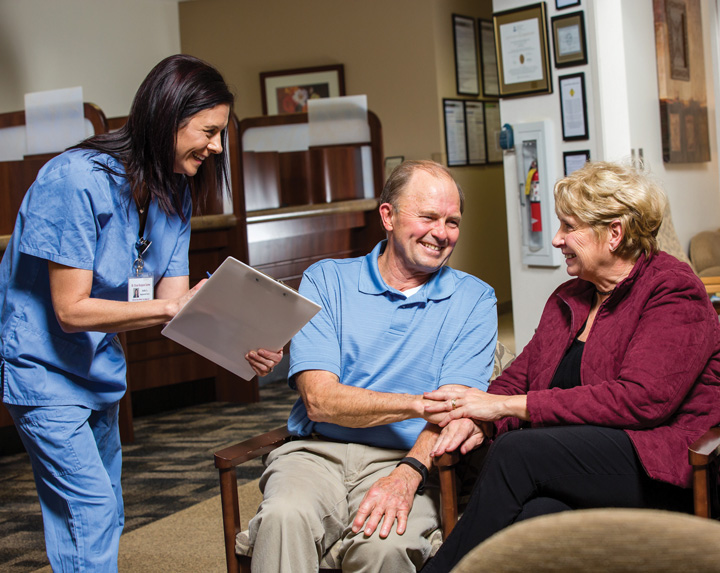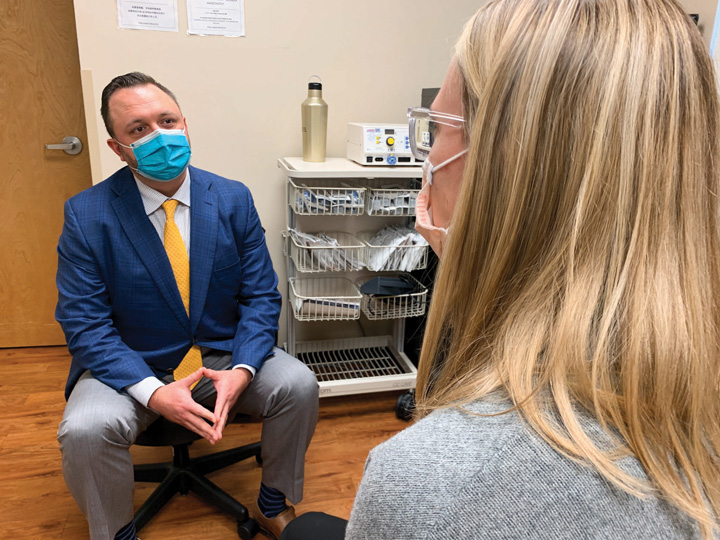- Home
- Article
Create a World-Class Total Joints Program
By: Jess White | Contributing Editor
Published: 2/20/2023
Key elements to consider when adding — or bolstering — this surging same-day service line.
Demand for same-day total joint replacements has never been higher for ASCs, thanks in part to a significant decrease in hospital inpatient procedures that began during the height of the COVID-19 pandemic and never really let up.
That means hordes of eager facilities across the U.S. are scrambling to add same-day total knee, hip and even shoulder replacements to their current offerings — or ramp up their existing lines. To stand out from the pack, ASC leaders must understand the marketplace and stay ahead of the competition.
Excellence is essential
Whether you’re rolling out a new total joints line or simply bolstering an existing one, excellence should always be your ultimate goal. A successful, top-rated total joint replacement program can help your ASC boost revenue and attract additional business.
To create a world-class total joint replacement program with the most favorable outcomes for patients, outpatient surgery centers must consider a variety of factors to achieve success. One element that’s especially critical is buy-in from your surgeons.
“You have to start with the surgeon or a team of surgeons who are going to be champions and are really motivated to move their patients to an outpatient setting for multiple reasons,” says Joseph Nessler, MD, an orthopedic surgeon at St. Cloud (Minn.) Surgery Center who specializes in total hip and knee replacements. “When you’re first starting up, it takes a lot of effort and input from your physicians to make sure everyone is on the same page.”
Along with surgeon buy-in, you’ll also need the support of staff from every level of your center, from nurses to therapists to the critical schedulers and administrative staff who keep the facility humming like a well-oiled machine. Team buy-in is essential since you’ll want their help to standardize the surgical process from start to finish in order to achieve an efficient high-volume line. That total buy-in must extend to areas such as procedure scheduling, patient education and post-op recovery.
“Staff must be aligned and experienced,” says Gregory DeConciliis, PA-C, CASC, administrator at Boston Out-Patient Surgical Suites in Waltham, Mass. “Success comes from proper planning and really outlining what your programs will look like from taking a patient to pre-op all the way to post-op.” It’s important to have a clear plan or clinical pathway that guides your total joint replacement process, DeConciliis adds.
It’s also helpful to have the whole care team present when developing this plan. “If you get everyone in the same room — anesthesia, nursing, techs, pre-op, the surgeon and even the PT — you can discuss how you’re going to do the whole thing and what it’ll look like, and develop pre-op criteria and admittance criteria,” says Mr. DeConciliis.
Once the planning structure is in place, it’s much easier for your total joints program to run efficiently. Staff need clear protocols to follow after the physician determines a patient is a good candidate for outpatient joint replacement surgery, and each step should be activated based on the established pathway with few deviations.
During this initial period, Mr. DeConciliis even suggests having the same staffers perform their pre-established roles for multiple procedures. In his experience, this was beneficial when it came time to expand the program later. “It was helpful for us to have the same personnel deal with the patients when we started,” he says. “Early on, consistency was essential. Along the way, we developed protocols and preferences that helped us train other staff as we brought them on.”
These initial “champions” also assisted with boosting buy-in for the program among newer, less experienced staff while helping them get up to speed quickly, which was a key factor in making sure patient outcomes were favorable after total joint replacement surgery.
Dr. Nessler takes this concept a step further with his OR personnel: Only staff who have been specifically trained on performing total joints procedures are allowed in the room during surgery. “Staff aren’t allowed to scrub in unless they’re on the total joints team,” says Dr. Nessler. “This protocol decreases turn-around time and decreases the time spent on the procedure, since everyone knows what to look for.”
Pitfalls of expansion

Having experienced staffers available for total knee and hip cases makes it much easier for ASCs to increase their patient volumes.
Before going full steam ahead with scaling, however, it’s important to make sure your facility has all the necessary resources at its disposal besides staff. Otherwise, you may hit roadblocks that prevent you from expanding into a world-class total joints center.
One critical area to check: the physical space your facility has available to perform the total joints cases in the first place. Dr. Nessler encourages leaders to do their due diligence early. “Look at your facility and make sure your ORs are going to be an adequate size with the proper configuration to do total joints,” he says. Many facilities have failed to fully factor in the impact of space constraints prior to starting up a program.
Space is an even bigger concern if you’re looking to increase the amount of total joints procedures your facility performs over time, adds Dr. Nessler. “Your ORs may be able to handle a few hundred procedures a year at the outset of your program,
but you’ll need to think bigger if your end goal is to handle several thousand procedures annually,” he says.
It’s important to begin with the end in mind when adding total joints to your ASC’s repertoire. Your plan should
account for any physical expansion you’ll need down the line and equipment that must be purchased. It should also account for other aspects of care that may need to be updated when performing a higher volume of knee and hip replacements, including
changes or additional purchases (washers, sterilizers, etc.) you might need in your sterile processing department.
When you’re first starting up, it takes a lot of effort and input from your physicians to make sure everyone is on the same page.
Joseph Nessler, MD
While it’s critical to have your end goal in mind for your facility’s total joint replacement procedures from the start, it’s also essential to set a reasonable timeline for scaling up your program. Start small and simple with patients who have fewer comorbidities, says Mr. DeConciliis.
“Be careful not to ramp up too quickly,” he says. “When you’re starting out, try not to deviate from your patient selection criteria too quickly. Hit the home runs early on. Then, as your staff get more experienced, you can expand and start caring for more complicated patients.”
Work smarter, not harder, with tech
You may also want to perform a detailed cost-benefit analysis when it comes to certain elements of your budget with total joints. While certain technologies, implants and medications may be more pricey in the short-term, they may ultimately help your facility achieve significant cost savings down the line — especially if they could potentially improve patient outcomes.
“Be open to exploring the use of higher-cost drugs and devices that may enhance patients’ experience and recovery,” says Mr. DeConciliis. “There are certain things you can spend money on, and the benefits come back to you tenfold.”
An example Mr. DeConciliis cites is the medication his facility uses for long-acting local anesthesia, a non-opioid injectable medication that can be used for pain management with orthopedic surgery. When administered prior to a procedure, it can
help patients stay pain-free long after the surgery is complete. This in turn makes patients’ first few days of recovery, traditionally the most painful, go much more smoothly. “This can help patients get over the hump, get them home safely
without any pain and allow them to recover better during those first few crucial days,” says Mr. DeConciliis.
Also, it’s a good idea to at least explore the use of technology and surgical advances that can allow staff to work smarter, not harder. Robotic-assisted procedures are one example, according to Dr. Nessler. Using handheld robotic devices or robotic arms can make hip and knee replacements more precise. And better executed procedures typically lead to improved outcomes, better and speedier recoveries and more satisfied patients.
Other advances that may contribute to improved outcomes and patient satisfaction rates include tech platforms like patient navigator apps. These allow facilities to communicate with patients and their families before and after surgery, giving them access to videos and handouts with detailed instructions designed to help them be proactive throughout the process. Patients can see how to do required physical therapy exercises, record any complications they might be experiencing and submit medical questions to providers.
“Patient navigator apps are the real wave of the future, so don’t discount the use of those,” says Mr. DeConciliis.
Negotiating bundled contracts

Another benefit of being open to new and cutting-edge technology at your ASC: Adoption may help tip the scales in your favor when making bundled payment arrangements with insurers. Payers may be more willing to work with your facility if you can prove you’re committed to lowering the costs of total joint replacements overall by helping patients recover faster and avoid unnecessary postoperative hospitalizations.
Much of the technology on the market today, from non-opioid pain control options to robotics and smart implants to patient communication apps, aim to do just that.
“Bundled contracts are helpful,” says Dr. Nessler. “Contracting with the insurers can ensure you’ll get an adequate price to cover your costs. Get ahead of the game and negotiate those things as soon as possible.”
Negotiations with insurers, he says, should be included in your planning process for establishing a total joint replacement program. Since outpatient costs of hip and knee replacements are already significantly lower than they are in hospital settings, ASCs have a unique advantage they can leverage in negotiations for bundled contracts.
Ensuring future success
After you’ve made a long-term plan for your facility’s total joints program, created a standardized clinical pathway for procedures, trained your staff and established your contracts and payment arrangements, it’s natural to think the hard work is over.
In reality, it’s only the beginning of a challenging, constantly evolving and, if done right, unimaginably rewarding process. Regularly monitoring and reviewing your total joints protocols and outcomes is vital to continued success.
Upon initially launching a total joint replacement program, Mr. DeConciliis held a big staff meeting over dinner where they finalized their clinical pathway and discussed what to expect.
They then revisited the process after about 10 total joints cases — and never stopped. “We meet about the program on a frequent basis to look at any deviations from the normal, and try to learn from it and improve,” says Mr. DeConciliis. “It’s not enough to just launch it — you’ll need to revisit it to see how things are going and make improvements.” OSM
.svg?sfvrsn=be606e78_3)
.svg?sfvrsn=56b2f850_5)